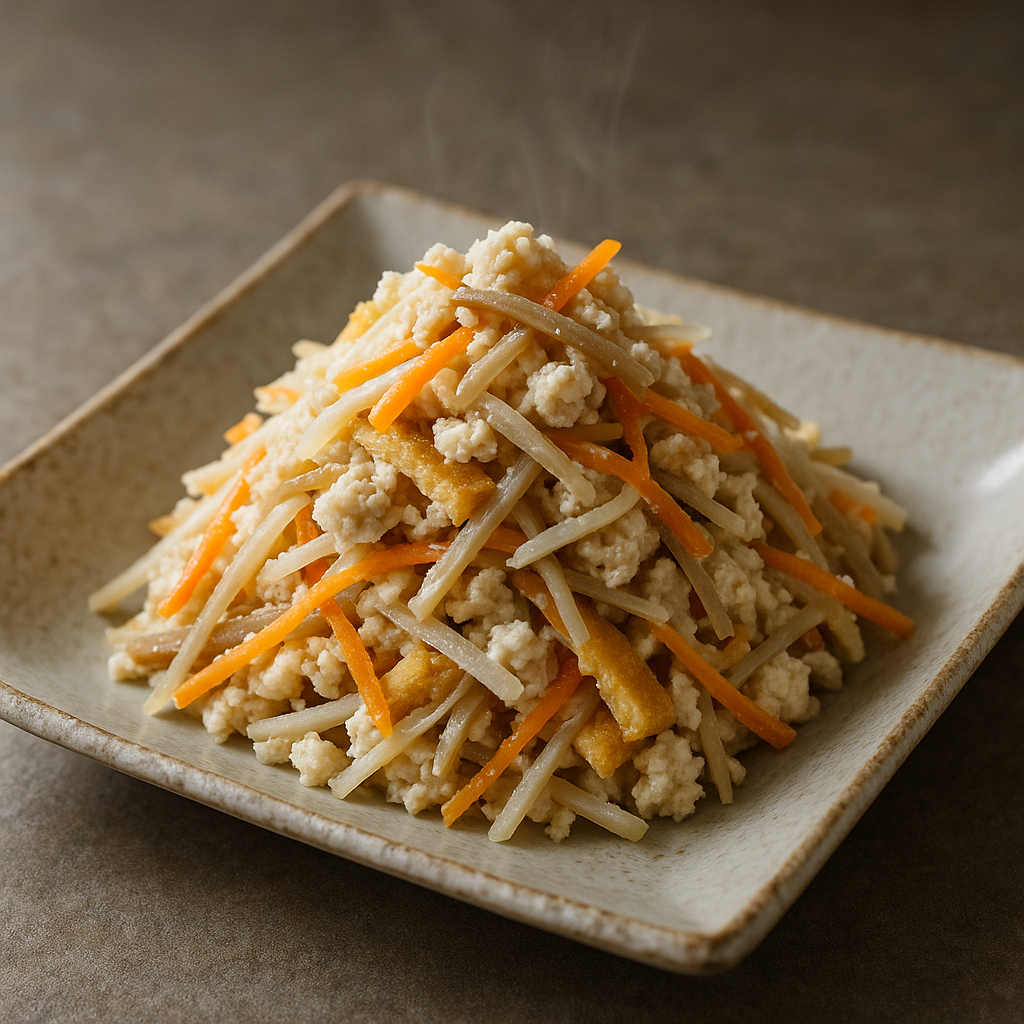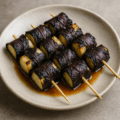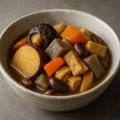煮あえっこの特徴
野菜と豆腐を“炒り煮”で仕上げる下北の常備菜
「煮あえっこ」は、大根や山菜、きのこを油でさっと炒め、崩した豆腐と調味料で水気がほどよく飛ぶまで“炒り煮”にする郷土料理。素朴なのにご飯が進む味わいです。
保存食材を活かす知恵
塩蔵や乾物の山菜、冬大根など、保存のきく素材を上手に組み合わせるのが特徴。季節や手に入る材料で自在にアレンジできます。
行事や集いの定番
日常のおかずはもちろん、冠婚葬祭や小正月にも大鍋で作られ、皆で分け合う“頼もしさ”が魅力です。
煮あえっこのレシピ
材料(4人分)
- 大根 … 500g(5cm長さのせん切り)
- にんじん … 50g(5cm長さのせん切り)
- ぜんまい(水煮) … 150g(5cm長さ)
- しいたけ … 3〜4枚(薄切り)
- 木綿豆腐 … 1/2丁(軽く水切りして手で崩す)
- 油揚げ … 1枚(細切り)
- 油 … 大さじ2
調味
- 醤油 … 大さじ2
- みりん … 大さじ2
- 塩 … ひとつまみ
作り方
- 下準備:大根・にんじんはせん切り、ぜんまいは食べやすく切る。しいたけは薄切り。豆腐はペーパーで軽く水切りし、油揚げは細切りにする。
- 炒める:鍋に油を熱し、にんじん→大根→ぜんまい→しいたけの順に炒め、全体に油を回す。
- 炒り煮:崩した豆腐を加えて混ぜ、醤油・みりん・塩で調味。弱めの中火で汁気が軽く飛ぶまで炒り煮にする。
- 仕上げ:油揚げを加えて全体になじませ、火を止めて数分おいて味を含ませる。
シェフのワンポイントアドバイス
豆腐は軽く水切りしてから崩すと水っぽくなりません。
大根は油をまとわせてから調味すると甘みと食感が生きます。冬は仕上げに岩のりを少量加えると香りとコクがアップ。
ぜんまいは手に入りづらいので、抜いて作るか山菜の水煮を使用すると楽です。
栄養価(1人分の目安)
- エネルギー:約150〜220 kcal
- たんぱく質:8〜12 g
- 脂質:7〜12 g
- 炭水化物:12〜20 g
野菜・豆腐・油揚げで栄養バランス良好。塩分は醤油量で調整しやすいです。
歴史
保存菜と根菜を生かした“混ぜ煮”文化
寒冷地の暮らしから生まれた、保存山菜や根菜、豆腐を無駄なく使う知恵の一品。各家庭で具材や味の濃さに個性が受け継がれています。
集いを支える大鍋料理
冠婚葬祭や季節の行事にたっぷり仕込み、皆で分かち合う地域の味として親しまれています。
English Version
Features of “Niae-kko”
A Shimokita pantry side finished by stir-simmering
Niae-kko is a local dish where daikon, wild greens, and mushrooms are lightly sautéed in oil, then mixed with crumbled tofu and seasonings and cooked down until the moisture is gently reduced. Simple, yet wonderfully rice-friendly.
Making the most of preserved ingredients
It characteristically combines storable foods—salted or dried mountain vegetables and winter daikon—so you can adapt it freely to the season and what you have on hand.
A staple for gatherings and family events
Beyond everyday meals, it is often cooked in big pots for weddings, funerals, and the Little New Year, to be shared by everyone.
Recipe
Ingredients (serves 4)
- Daikon … 500 g (matchsticks, about 5 cm long)
- Carrot … 50 g (matchsticks, about 5 cm long)
- Zenmai (bracken fern, parboiled) … 150 g (5 cm lengths)
- Shiitake … 3–4 caps (thinly sliced)
- Firm tofu … 1/2 block (lightly drained; crumble by hand)
- Abura-age (fried tofu) … 1 sheet (thinly sliced)
- Oil … 2 tbsp
Seasoning
- Soy sauce … 2 tbsp
- Mirin … 2 tbsp
- Salt … a pinch
Instructions
- Prep: Cut daikon and carrot into matchsticks; cut zenmai to bite size; slice shiitake. Lightly drain tofu on paper towels and slice the abura-age.
- Sauté: Heat oil in a pot and sauté in order—carrot → daikon → zenmai → shiitake—until coated with oil.
- Stir-simmer: Add crumbled tofu, then season with soy sauce, mirin, and salt. Cook over medium-low heat, stirring, until the liquid reduces slightly.
- Finish: Add abura-age, toss to combine, turn off the heat, and let it sit a few minutes to absorb flavor.
Chef’s Tip
- Lightly drain the tofu before crumbling so the dish won’t get watery.
- Coating the daikon in oil before seasoning brings out sweetness and keeps texture.
- If zenmai is hard to find, omit it or use a mixed mountain-vegetable pack (boiled). A touch of rock seaweed in winter adds aroma and depth.
Nutritional Value (per serving, approx.)
- Calories: 150–220 kcal
- Protein: 8–12 g
- Fat: 7–12 g
- Carbohydrates: 12–20 g
Balanced across vegetables, tofu, and abura-age. Salt is easy to control by adjusting soy sauce.
History
A “mixed simmer” born of preserved greens and roots
Developed in a cold-climate lifestyle that made full use of stored mountain vegetables, root crops, and tofu—each household handing down its own choice of ingredients and seasoning strength.
A big-pot dish that supports community gatherings
For ceremonies and seasonal events it’s cooked in generous batches and shared, remaining a cherished taste of the region.



何でも質問してください!